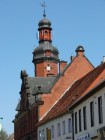Drezdenko

The Commune of Drezdenko is located in the central part of Gorzów Valley stretching across the ice-marginal valley of the River Noteć, from the edge of the Drawa Primeval Forest to the borders of the Noteć Primeval Forest. Its numerous clear lakes and other water bodies have the total area of 750 ha. The area of the Commune of Drezdenko is around 400 sq km, 65% of which is covered by forests. The population is approximately 17,000. The centre of the commune is the town of Drezdenko, located by the River Noteć, with population of 10,000. The nearby railway linking Krzyż to Kostrzyn by the Oder provides a convenient connection to Berlin. The main areas of industry that develop in the commune are timber, food, metal and paper industries.

At the very beginning of the Polish statehood, Drezdenko played a much more important part than nowadays. The town was built on an island and its residents were supposed to control the traffic along one of the most important transport routes in Poland, which ran from Poznań to Szczecin. The exact date of founding the town is unknown, although some historian argue that it already existed before the 11th century, as first mentions (according to which the town was established in 1092) can be found in Jan Długosz’s “Chronicle”. However, the most important documents that confirm the existence of the town do not date back further than 1233, when Ladislaus Odonic visited “Drzina,” as the name was put therein. In addition, documents from 1234 mention “Castrum Drecen”. By 1251 Drezdenko had already been a castellan’s seat, as documents from that period mention castellan named Bogut, who was to be followed by Dzierżykraj and Włost. Although the exact total number of castellans is unknown, we do know that in 1296, after the period of Polish-German wars, Drezdenko was incorporated into Brandenburg. A hypothesis was put forward that Poland briefly regained it in 1309, but as soon as 1314 it was again taken over Brandenburg that ruled the area for almost a century. The most important event of that period was granting a charter to Drezdenko in 1317. It came into possession of the van der Ost family of knights from Pomerania. In 1356 Drezdenko became a fiefdom of Poland. In 1402 Ulrich von der Ost, the owner of the town, paid homage to Ladislaus Jagiello, but he later refused to hand Drezdenko over to the king. In 1405 the land was invaded by the Teutonic Knights, who forced von der Ost to sell the castle. In the so-called Wolbrom memorial (1409), Ladislaus Jagiello accused them of annexation of Drezdenko. The disputes over the town, that dragged on for years, were one of the causes of the Polish-Teutonic war in the period 1409-1411. The Old Town was encircled by defensive walls with three gates. The castle and the walls were reconstructed in the period 1444-1455. In 1455 the town was sold to Brandenburg elector Frederick II. Thus the most tumultuous period in the history of Drezdenko came to an end, as the fighting stopped. What followed were several centuries of German rule and the town’s development. In 1600 a saltworks was established and Drezdenko grosz, i.e. a small coin, was minted for the purposes of trading with Poland. In 1603-1605 the fortress was constructed. Then two disasters took place. The first one was the fire of 1622 that consumed almost all buildings, and the second one was the Swedish invasion in 1637, which resulted in total destruction of the town. The Swedes had been harassing the residents of the town for 10 years. Then Drezdenko enjoyed a period of relative peace, which ended in 1758 with the arrival of the Russians troops, who had been stationing there for the next 4 years and even after that Drezdenko remained a garrison town for a long period of time. In addition, the town suffered 7 plagues that broke out in the region in the period 1758-1866. In 1763 a new town was founded. It was located between of the Old Town and the fortress. In 1766 a late Gothic palace was constructed on the ruins of the fortress. Today it is the Junior Secondary School No. 1. The 19th century saw an even faster development of the town. In 1812-1819 the Civic Guard was established to keep the public order in Drezdenko. A new school building was constructed, the seat of the town authorities was moved to a new town hall, a hospital and a prison were opened, a town slaughterhouse began its activity, the construction of the courthouse was finished, and many new roads, including the one linking Drezdenko to Międzychód, were built. In addition, a ceramics factory, two sawmills and a match factory started production. However, the town was not spared by cholera epidemics in 1831 and 1855. In 1901 the post office and the gasworks were opened. Thus, the town was provided with street lighting. 1902 saw the end of the construction of the church and two years later the building of the primary school (currently the Janusz Korczak Primary School) was finished. In 1907 the water and sewage system was installed in the town. One year later a nursing home and an orphanage were established. In 1933 Drezdenko gained its own railway station. The second world war was a breakthrough period in the town’s history. In 1945 it was incorporated into Poland. That year saw also the opening of the Stefan Żeromski High School and the cinema. In 1958 the Town Cultural Centre was established and in 1967 Nowe Drezdenko was incorporated into the town limits. Another important event was probably winning the title of “the Leader of Economic Efficiency”, granted to Polish towns, in 1967 – the feat which was repeated in 1976.
źródło: www.drezdenko.pl
Drezdenko - galeria
 |
 |
 |
 |
|
